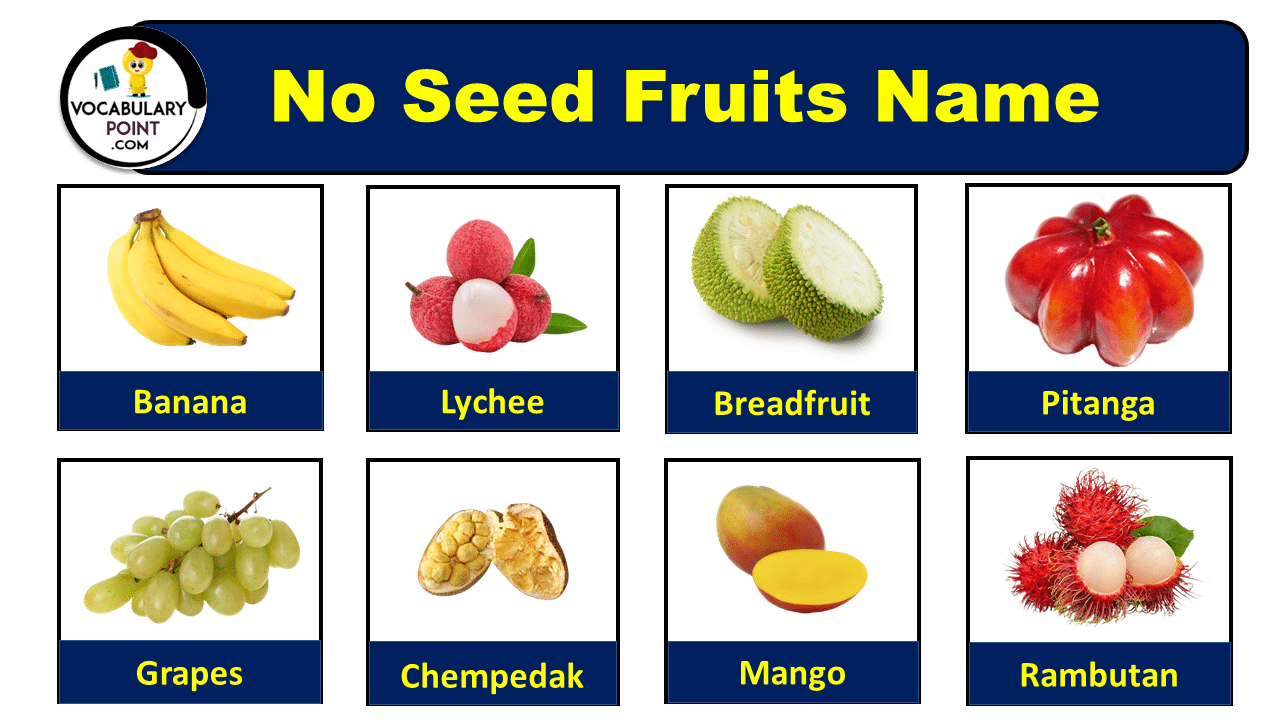Have you ever wondered about the different types of fruits that don’t have seeds? These fascinating and unique fruits not only provide a burst of flavor, but they also offer a convenient and seedless eating experience. From juicy watermelons to sweet bananas, there is a wide variety of seedless fruits that are both delicious and nutritious. In this article, we will explore an extensive list of no-seed fruits that will leave you amazed by nature’s ingenuity. So get ready to discover some extraordinary fruit varieties that defy the traditional notion of seeds!
List Of Seedless Fruits
Chayote
A green, pear-shaped squash that belongs to the gourd family, eaten cooked or raw, with a mild flavor.
Whitecurrant
A small, sweet, translucent white berry, related to red and black currants, used in desserts and jams.
Yangmei
Also known as Chinese bayberry, a sweet and sour fruit with a rough texture, consumed fresh or dried.
Karanda
A small, tart berry native to Asia, used in pickles, jams, and traditional medicine.
Finger Lime
A citrus fruit with caviar-like pearls inside, offering a burst of tangy flavor, used as a garnish.
Wampee
A small, yellow fruit with a sweet and sour flavor, native to Southeast Asia, used in desserts and drinks.
Avocado
A creamy, fatty fruit, green when ripe, used in a variety of dishes, from salads to guacamole.
Banana
A long, yellow fruit with soft, sweet flesh, high in potassium, eaten fresh or used in cooking and baking.
Kwai Muk
A tropical fruit with an orange-red skin and sweet, slightly acidic flesh, eaten fresh or made into jelly.
Tangerine
A small, sweet citrus fruit with a loose skin, similar to oranges but sweeter and less acidic.
Coconut
A large, brown fruit with a hard shell, white flesh, and clear liquid inside, used in many culinary applications.
Gooseberry
A small, tart fruit, can be green, red, or purple, used in pies, jams, and savory dishes.
Kiwi
A small, brown fruit with bright green flesh and tiny, edible black seeds, known for its sweet and tangy flavor.
Tamarind
A pod-like fruit with a tangy pulp used in cuisines worldwide for its sour flavor in dishes and candies.
Orange
A citrus fruit known for its juicy, sweet flavor and high vitamin C content, used fresh or in juices.
Buddha’s Hand
A citrus fruit with a unique shape of finger-like sections, used primarily for its zest and aromatic qualities.
Duku
A type of langsat fruit, with a thick skin and sweet, juicy segments inside, common in Southeast Asia.
Pineberry
A white strawberry cultivar with red seeds, tastes similar to pineapple, a novelty in fruit markets.
Apricot
A small, orange fruit with a sweet, slightly tart flesh, used fresh, dried, or in cooking.
Honeydew
A sweet melon with a smooth, pale green skin and light green flesh, known for its high water content.
Grapes
Small, juicy fruits grown in clusters on vines, used in making wine, raisins, and eaten fresh.
Kiwifruit
A small, brown fruit with bright green or yellow flesh and tiny black seeds, known for its tangy flavor.
Lime
A green, citrus fruit known for its acidic juice, used in beverages, cooking, and baking.
Lemon
A bright yellow, sour citrus fruit, widely used for its juice, zest, and as a flavoring in various dishes.
Eggfruit
A tropical fruit with a yellow, egg-like flesh that is sweet and custard-like, eaten raw or used in desserts.
Fig
A sweet fruit with a soft interior filled with tiny seeds, eaten fresh or dried, and used in cooking.
Jambolan
Also known as Java plum, a purple-black berry with a sweet and slightly astringent flavor.
Dragonfruit
A brightly colored fruit with a speckled, white or red flesh, known for its mild, sweet taste.
Osage Orange
A large, green, brain-like fruit, not commonly eaten, often used as a natural insect repellent.
Raspberry
A soft, red or black fruit, known for its sweet and slightly tart flavor, used in a wide range of dishes.
Langsat
A tropical fruit with translucent, juicy flesh and a sweet-tart flavor, encased in thin, yellow skin.
Jackfruit
The largest tree-borne fruit, known for its sweet, aromatic bulbs of yellow flesh, used in sweet and savory dishes.
Sugar Apple
Also known as sweetsop, a green, scaly fruit with sweet, custard-like flesh, eaten fresh.
Papaya
A tropical fruit with orange flesh and black seeds, known for its sweet taste and digestive benefits.
Blackcurrant
A small, tart, black berry, rich in vitamins and antioxidants, used in making jams, juices, and flavorings.
Pineapple
A tropical fruit with a rough, spiky exterior and sweet, juicy, yellow flesh inside.
Strawberry
A sweet, red fruit with a fragrant aroma, popular worldwide, used fresh and in a variety of culinary dishes.
Mangosteen
A tropical fruit with a thick, purple rind and sweet, tangy white segments inside, known as the “queen of fruits.”
Guanabana
Also known as soursop, a tropical fruit with a spiky green exterior and soft, creamy texture inside, known for its sweet-sour flavor.
Velvet Apple
A tropical fruit with a velvety skin and sweet, creamy flesh, less common outside its native regions.
Boysenberry
A large, juicy berry, a cross among blackberry, raspberry, and loganberry, dark purple when ripe.
Palmyra Palm Fruit
A tropical fruit from the palmyra palm, sweet and translucent, consumed fresh or made into desserts.
Sapote
A term for several tropical fruits with sweet, custard-like flesh, including mamey sapote and black sapote.
Horned Melon
Also known as kiwano, an orange fruit with horn-like spikes, offering a jelly-like texture with a mild taste.
Ackee
A tropical fruit, part of Jamaican cuisine, must be properly prepared to avoid toxicity.
Burahem
Not a widely recognized fruit name; may require clarification or could be a regional or local name.
Loquat
A small, yellow fruit with a tangy-sweet flavor, native to China, used in jams and pies.
Guava
A tropical fruit with a green rind and pink or white flesh, eaten fresh or used in beverages.
Chempedak
A large, tropical fruit similar to jackfruit, with sweet, aromatic bulbs of flesh, used in Southeast Asian cuisine.
Lychee
A tropical fruit with a rough, red skin and sweet, fragrant flesh surrounding a large seed.
Sapodilla
A tropical fruit with a grainy, sweet flesh, brown skin, and a flavor reminiscent of pears or brown sugar.
Ugli Fruit
A citrus fruit with a rough, greenish-yellow skin, known for its sweet and tangy flavor.
Noni
A tropical fruit known for its strong, pungent smell and bitter taste, often used in traditional medicine.
Mango
A tropical fruit with a sweet, juicy flesh and a stone in the center, consumed fresh or used in a variety of dishes.
Peach
A soft, juicy fruit with a velvety skin and sweet flesh, ranging in color from white to yellow or red.
Pear
A sweet fruit with a grainy texture, comes in green, yellow, and red varieties, used fresh or in cooking.
Salak
Also known as snake fruit, a tropical fruit with reddish-brown scaly skin and sweet, crunchy flesh.
Apple
A popular fruit with varieties ranging from sweet to tart, consumed fresh, cooked, or used in beverages.
Plumcot
A hybrid fruit combining the flavors of plums and apricots, with sweet, juicy flesh.
Surinam Cherry
A tropical fruit with a ribbed, pumpkin-shaped appearance and a tart, cherry-like flavor.
Barbados Cherry
A small, red fruit, also known as acerola, high in vitamin C, with a sweet-tart flavor.
Cherry
A small, round fruit with a pit, ranging from sweet to tart, used fresh or in cooking and baking.
Feijoa
A small, green fruit with a unique taste that combines the flavors of pineapple, guava, and mint.
Graviola
Also known as soursop, a fruit with a spiky exterior and a soft, sweet interior, used in juices and smoothies.
Açaí Berry
A small, dark purple berry, known for its antioxidant properties, used in smoothie bowls and health supplements.
Nectarine
A smooth-skinned fruit similar to a peach, with a firmer, sweeter flesh.
Olallieberry
A cross between loganberry and youngberry, known for its sweet and tart flavor, used in pies and jams.
Mulberry
A fruit that can be white, red, or black when ripe, sweet and slightly tart, used fresh or in cooking.
Redcurrant
A small, tart, red berry, used in cooking, baking, and preserves.
Imbe
A tropical fruit with a sweet and sour flavor, known for its bright orange skin and juicy, vitamin-rich pulp.
Pequi
A Brazilian fruit with a strong taste and aroma, used in traditional dishes, caution required due to internal spines.
Pomegranate
A fruit with a tough outer shell that encases sweet, juicy seeds, known for its health benefits.
Blueberry
A small, blue-purple berry, sweet and nutritious, often eaten fresh or used in baking and preserves.
Gac Fruit
A Southeast Asian fruit with spiky skin, known for its high beta-carotene content, used in traditional dishes.
Watermelon
A large, refreshing fruit with a green rind and juicy, sweet red flesh, containing black seeds.
Jabuticaba
A Brazilian fruit that grows directly on the trunk, dark purple-black with a sweet, grape-like flavor.
Mabolo
Also known as velvet apple, a tropical fruit with a velvety skin and sweet, creamy flesh, less common outside its native regions.
Miracle Berry
A berry that alters taste perception, making sour foods taste sweet, used as a novelty and in culinary experiences.
Passionfruit
A tropical fruit with a hard outer rind and juicy, seed-filled interior, known for its intense, tropical flavor.
Persimmon
A sweet, orange fruit that can be astringent or non-astringent, eaten fresh or dried.
Currant
Small, tart berries, can be black, red, or white, used in cooking, baking, and preserves.
Pitanga
Also known as Surinam cherry, a tropical fruit with a ribbed, pumpkin-like shape and a tangy flavor.
Yuzu
A citrus fruit from East Asia, known for its unique, aromatic flavor, used primarily for its zest and juice.
Camu Camu
A small, sour berry from the Amazon rainforest, known for its extremely high vitamin C content.
Cranberry
A tart, red berry, used in juices, sauces, and baking, known for being associated with Thanksgiving.
Rambutan
A tropical fruit with hairy red and green skin, covering sweet, translucent flesh around a seed.
Santol
A tropical fruit with a cotton-like texture surrounding the seeds, eaten fresh or used in cooking.
Pulasan
Similar to rambutan, but with a sweeter taste and thicker skin, containing juicy, sweet segments.
Olive
A small, oily fruit, green when unripe and black when ripe, used in cooking and for olive oil.
Soursop
Also known as graviola, a tropical fruit with a spiky green exterior and soft, creamy texture inside, known for its sweet-sour flavor.
Miracle Fruit
Also known as miracle berry, changes sour flavors to sweet, used for flavor-altering experiences.
Clementine
A type of mandarin orange, small and sweet with seedless, easy to peel segments.
Plum
A juicy fruit with a variety of colors and flavors, ranging from sweet to tart, used fresh and in cooking.
Cantaloupe
A type of melon with orange flesh and a netted skin, known for its sweet flavor.
Blackberry
A dark, edible berry, known for its juicy, sweet, and slightly tart flavor, used in desserts and jams.
Bignay
A small, red or black fruit native to Southeast Asia, tart when raw but sweet when ripe, used in wines and jams.
Breadfruit
A large, tropical fruit, starchy and used as a vegetable in many cuisines, eaten cooked.
Tomato
A red, juicy fruit often used as a vegetable in cooking, versatile in salads, sauces, and dishes.
Sweetsop
Also known as sugar apple, a fruit with sweet, creamy flesh and a green, scaly exterior.
Explore More Fruits Names:
Green Fruits | Red Fruits | Smallest Fruits
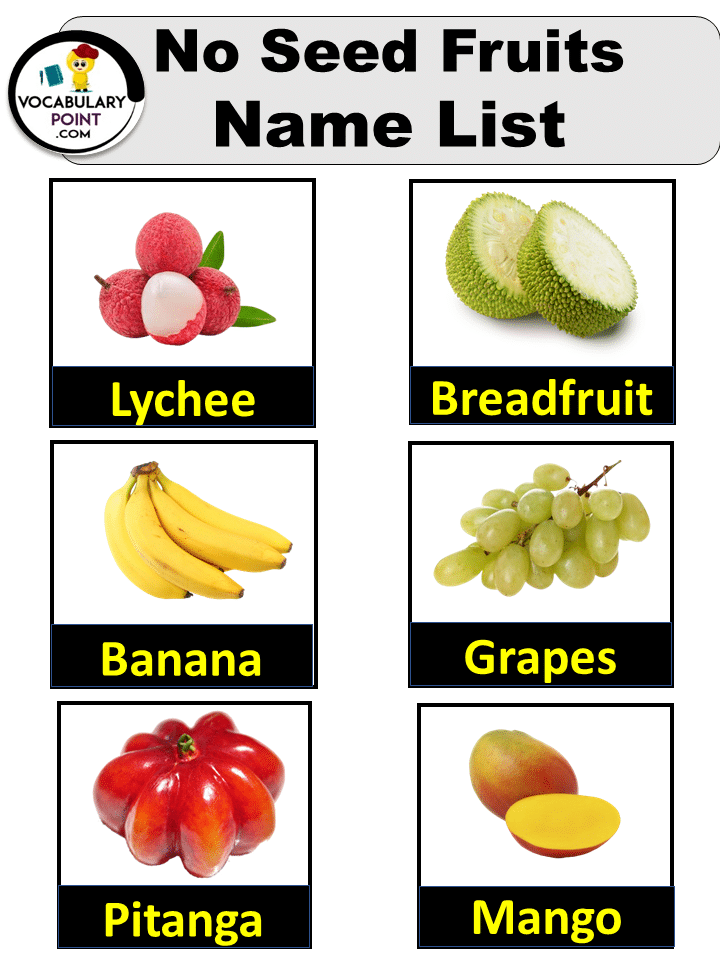
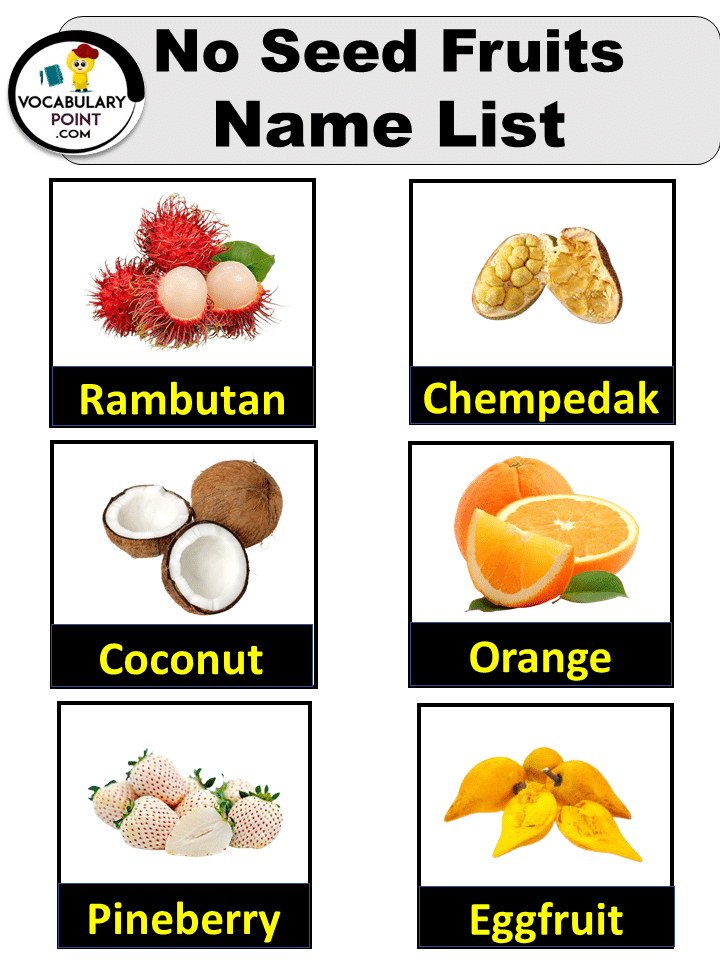
Fruits That Have No Seed
Lychee
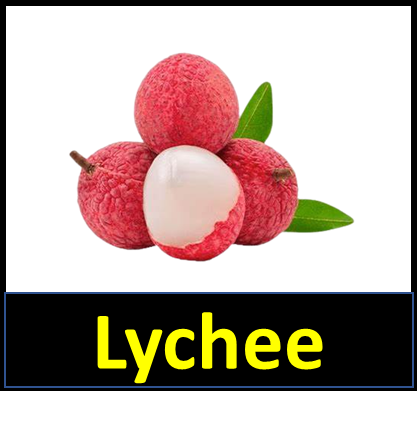
- Rich in Antioxidants:
Lychee is a fruit packed with powerful antioxidants that help combat oxidative stress, reducing the risk of chronic diseases and promoting overall health.
- Immune System Support:
With its high content of vitamin C, lychee boosts the immune system, aiding in the body’s defense against infections and illnesses.
- Digestive Aid:
Lychee contains dietary fiber, which supports healthy digestion by promoting regular bowel movements and preventing digestive discomfort.
Breadfruit
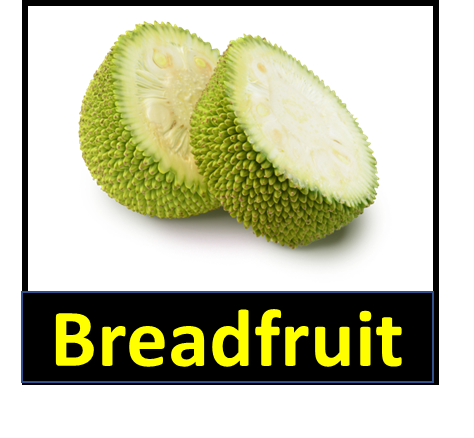
- Nutrient-Rich:
Breadfruit is abundant in essential nutrients, offering a wide array of vitamins, minerals, and dietary fiber that contribute to overall health and vitality.
- Satiety and Weight Management:
The dietary fiber content in breadfruit helps promote a feeling of fullness, aiding in controlling appetite and supporting weight management goals.
- Heart Health:
With its potassium content, breadfruit contributes to maintaining healthy blood pressure levels, which is crucial for reducing the risk of cardiovascular issues.
Banana
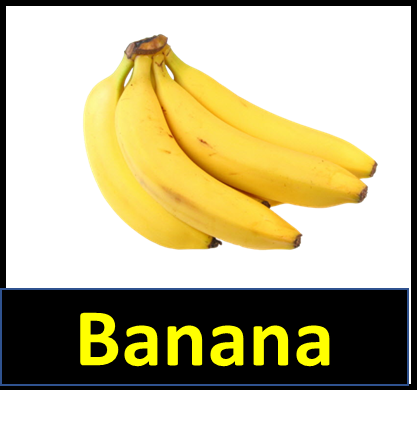
- Potassium Source:
Bananas are a rich source of potassium, a mineral that helps regulate blood pressure and supports proper muscle and nerve function.
- Energy Boost:
Packed with natural sugars and carbohydrates, bananas provide a quick and sustained energy boost, making them an excellent choice for pre- or post-workout snacks.
- Mood Enhancement:
Bananas contain tryptophan, a precursor to serotonin, a neurotransmitter that contributes to mood regulation, potentially aiding in improving mood and reducing feelings of stress or anxiety.
Grapes
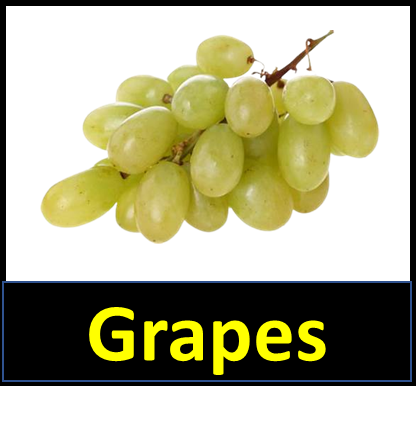
- Antioxidant-Rich:
Grapes are abundant in antioxidants like resveratrol, which can help protect cells from oxidative damage and contribute to overall health.
- Heart Health:
The natural compounds in grapes promote cardiovascular well-being by supporting healthy blood pressure levels and enhancing blood vessel function.
- Digestive Support:
Grapes contain dietary fiber that aids in digestion, promoting regular bowel movements and a healthy gut environment.
Pitanga
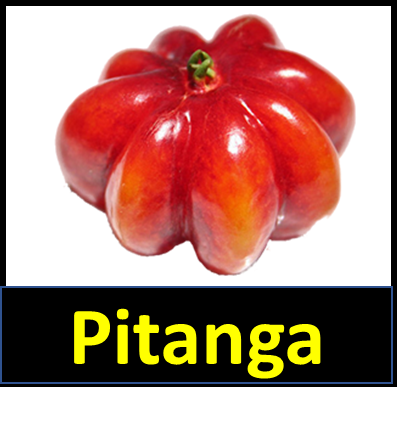
- Rich in Vitamin C:
Pitanga is a fruit that is high in vitamin C, which plays a vital role in supporting the immune system and promoting skin health.
- Antioxidant Properties:
Pitanga contains antioxidants that help protect cells from damage caused by free radicals, contributing to overall well-being.
- Blood Sugar Regulation:
Compounds found in pitanga may assist in regulating blood sugar levels, which is beneficial for individuals managing diabetes or seeking to maintain stable energy levels.
Mango

- Nutrient-Dense:
Mangoes are packed with essential vitamins, minerals, and dietary fiber, offering a wide range of nutrients to support overall health.
- Skin Health:
The high content of vitamins A and C in mangoes promotes healthy skin by supporting collagen production and protecting against oxidative damage.
- Digestive Aid:
Mangoes contain enzymes like amylases and proteases that assist in digestion, potentially alleviating digestive discomfort and promoting a healthy gut.
Rambutan
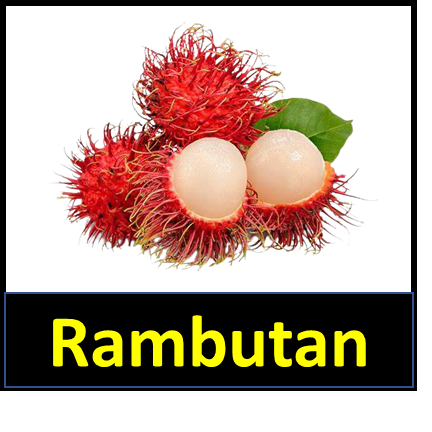
- Rich in Antioxidants:
Rambutan is abundant in antioxidants that help combat oxidative stress and promote overall health by protecting cells from damage.
- Immune System Support:
The high vitamin C content in rambutan boosts the immune system, aiding in the body’s defense against infections and illnesses.
- Skin Health:
Rambutan contains beneficial compounds that can contribute to skin health, potentially improving complexion and supporting collagen production.
Chempedak

- Nutrient-Rich:
Chempedak is packed with essential nutrients, providing a diverse range of vitamins, minerals, and dietary fiber that contribute to overall health.
- Energy Source:
Chempedak is a good source of carbohydrates and natural sugars, offering a quick and sustained energy boost to support physical activity and vitality.
- Digestive Support:
Chempedak contains dietary fiber that aids in digestion, promoting regular bowel movements and supporting a healthy gut environment.
Coconut
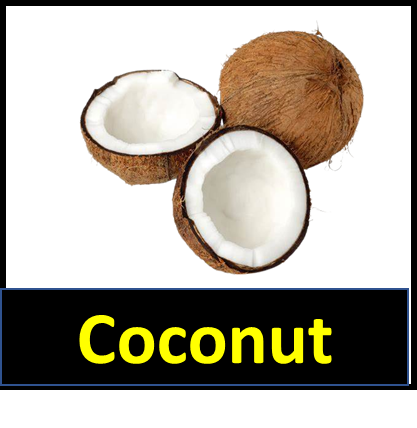
- Hydration Support:
Coconut water is a natural electrolyte-rich beverage that helps maintain proper hydration levels, making it an excellent choice for replenishing fluids.
- Nutrient-Dense:
Coconuts offer essential vitamins, minerals, and healthy fats that contribute to overall well-being and can support various bodily functions.
- Skin and Hair Health:
The natural oils found in coconuts have moisturizing properties that can nourish and improve the health of both skin and hair.
Orange

- Vitamin C Source:
Oranges are rich in vitamin C, which is crucial for supporting the immune system, skin health, and wound healing.
- Antioxidant Content:
Oranges contain antioxidants that help protect cells from oxidative damage, potentially reducing the risk of chronic diseases.
- Dietary Fiber:
Oranges provide dietary fiber, which supports digestive health by promoting regular bowel movements and preventing constipation.
Pineberry
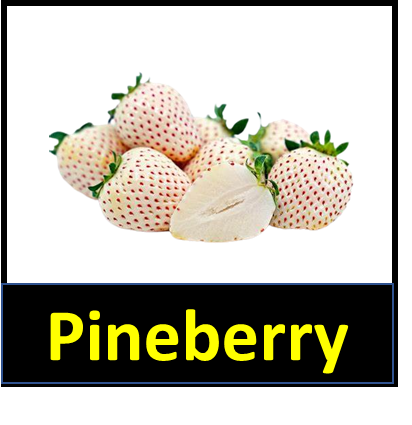
- Unique Flavor:
Pineberries offer a distinct flavor profile that combines the sweetness of strawberries with the tanginess of pineapples, providing a unique taste experience.
- Antioxidant Properties:
Pineberries contain antioxidants that can help neutralize harmful free radicals, contributing to overall health and potentially reducing the risk of certain diseases.
- Nutrient Variety:
While less common, pineberries still provide vitamins, minerals, and dietary fiber, contributing to a well-rounded nutrient intake for overall well-being.
Eggfruit
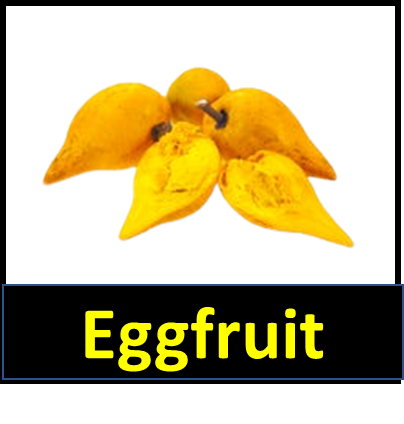
- Nutrient-Rich:
Eggfruit is packed with essential nutrients, offering a variety of vitamins, minerals, and dietary fiber that contribute to overall health.
- Satiety and Weight Management:
The dietary fiber and healthy fats in eggfruit can promote a feeling of fullness, aiding in appetite control and supporting weight management efforts.
- Heart Health:
Eggfruit contains healthy monounsaturated fats that can contribute to heart health by helping to lower bad cholesterol levels and reducing the risk of cardiovascular issues.
